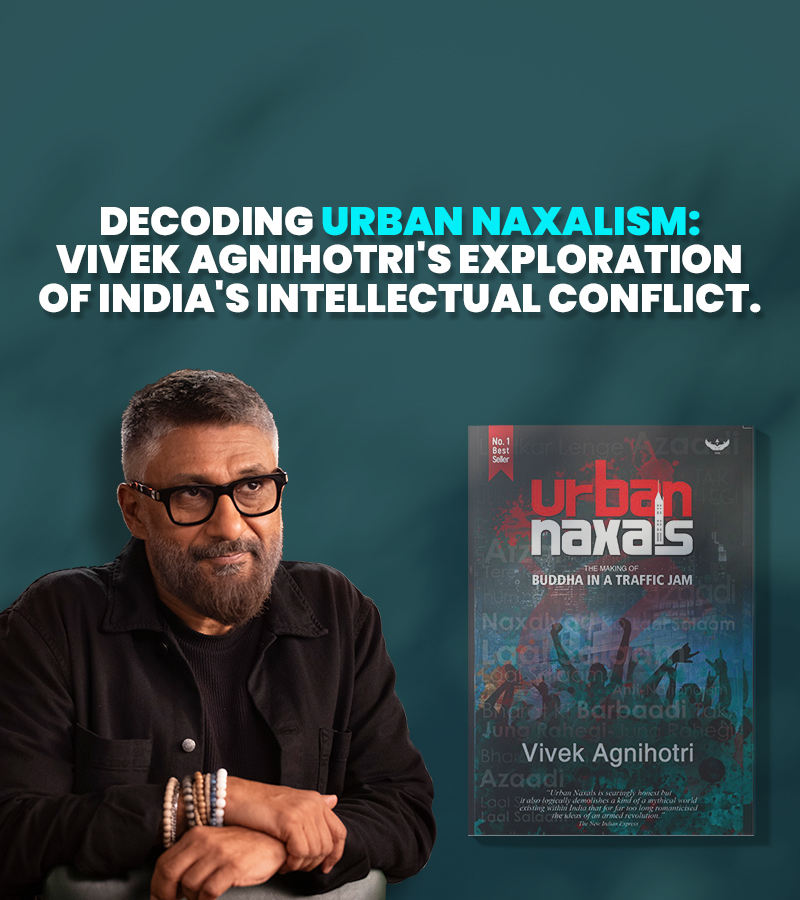

What is Urban Naxalism and How Does It Impact Modern India
It’s not just a phrase; Urban Naxalism impacts every aspect of Indian society and politics. Understanding this urgent issue is crucial. Find out how.
Urban Naxalism, a term popularized by filmmaker and author Vivek Agnihotri, refers to the phenomenon of intellectuals, influencers, and activists supporting Naxalite insurgents. This blog explores the concept of Urban Naxalism, its origins, and its impact on contemporary Indian society and politics. And we also talk about how Vivek Agnihotri’s films and books have significantly contributed to our understanding of it.
But first, let’s understand what is Naxalism?
Naxalism traces its roots to the late 1960s in the village of Naxalbari, West Bengal. Disillusioned with the government’s failure to address issues of land reform and economic disparity, a group of communist rebels led by Charu Majumdar and Kanu Sanyal launched a violent uprising. The movement quickly spread across rural India, advocating overthrowing the state through armed struggle. Initially, Naxalism was concentrated in remote and tribal areas. Still, over the decades, its influence has permeated urban centers, leading to the emergence of Urban Naxalism.
What is Urban Naxalism?
As introduced by Vivek Ranjan Agnihotri in his book Urban Naxals: The Making of Buddha in a Traffic Jam, Urban Naxalism refers to the ideological and logistical support provided by armchair intellectuals to the Naxalite movement. These individuals, often embedded within academia, media, and civil society, are known for radicalizing youth, influencing public opinion, and creating unrest under the guise of social justice and human rights.
Vivek Agnihotri’s book and subsequent film, Buddha in a Traffic Jam, dissect how these urban elements collaborate with rural insurgents. The term sparked widespread debate, with critics arguing that it is used to suppress dissent and target activists. At the same time, proponents believe it highlights a genuine threat to national security. This debate has been featured in numerous media outlets and academic discussions, demonstrating the significant impact of Agnihotri’s work.
How does Urban Naxalism Impact Contemporary Indian Society
Polarizing public discourse: Urban Naxalism has significantly divided public discourse in India. Proponents argue that these urban supporters of Naxalism pose a severe threat to national security by inciting violence and spreading propaganda. Conversely, critics claim that the term stifles legitimate dissent and activism, creating an atmosphere of fear and mistrust.
Changed perception of media & academia: The concept has brought considerable scrutiny to media and academia, with allegations that these institutions are the backyard of Urban Naxals. It often leads to a contentious debate over freedom of expression and the role of intellectuals in society. Vivek Ranjan Agnihotri’s work has been pivotal in bringing these issues to the forefront, often challenging the narratives presented by mainstream media and academic circles.
Legal implications are involved: The government has responded to the threat of Urban Naxalism proactively, leading to arrests and legal actions. This has sparked debates over civil liberties and the balance between security and freedom. Vivek Agnihotri’s films and books highlight these tensions, urging a reevaluation of how society addresses internal security threats while respecting democratic principles.
Vivek Agnihotri’s Contributions
Vivek Agnihotri has been instrumental in bringing the concept of Urban Naxalism to mainstream consciousness. His movie Buddha in a Traffic Jam portrays the nexus between urban intellectuals and rural insurgents, offering a dramatized account of how these alliances operate. The film received critical acclaim and sparked widespread debate, highlighting issues often overlooked in mainstream media.
In his book about Urban Naxals, Vivek Agnihotri provides a detailed account of his experiences and observations, arguing that the infiltration of Naxalite ideology into urban areas poses a significant threat to national security. He urges readers to recognize and address this issue, advocating for a more vigilant and informed approach to dealing with insurgency.
Vivek Ranjan Agnihotri’s narrative of Urban Naxalism has also influenced popular culture, leading to many films, books, and discussions centered on this theme. It has encouraged a broader examination of the social and economic factors that contribute to radicalization and the role of urban intellectuals in shaping public opinion.
How is it connected to Cinema and Literature?
Vivek Ranjan Agnihotri’s work exemplifies how cinema and literature can influence public perception and spark meaningful dialogue on critical issues. By blending factual accounts with compelling storytelling, he has managed to engage a broad audience and bring attention to the complexities of Urban Naxalism. His approach underscores the power of narrative in shaping public discourse and encouraging critical thinking.
Conclusion
Urban Naxalism remains a contentious and complex issue in contemporary India. Its impact on society, politics, and public discourse profoundly highlights the challenges of balancing security with civil liberties. Vivek Agnihotri’s contributions through his films and books have brought this issue to light, urging a deeper examination of the ideological battles shaping modern India.
As India grapples with these challenges, fostering an environment where diverse perspectives can be explored and debated is crucial. By doing so, society can work towards solutions that uphold democratic values while ensuring national security. Urban Naxalism, as depicted by Agnihotri, serves as a reminder of the need for a balanced approach, informed dialogue, and a commitment to addressing the root causes of insurgency and radicalization.






